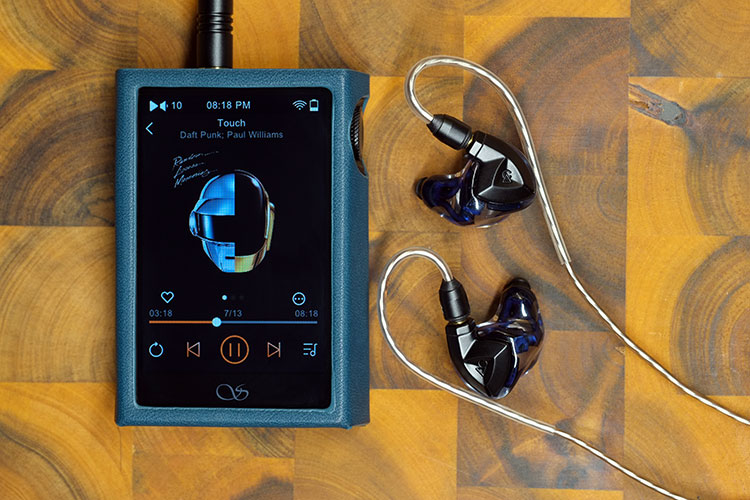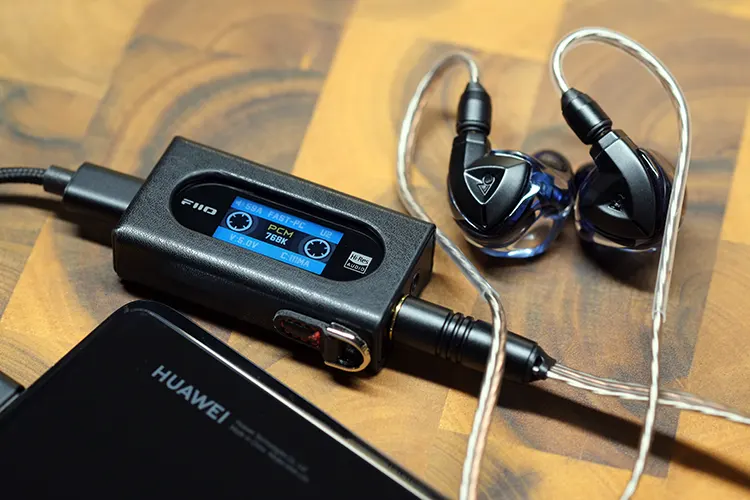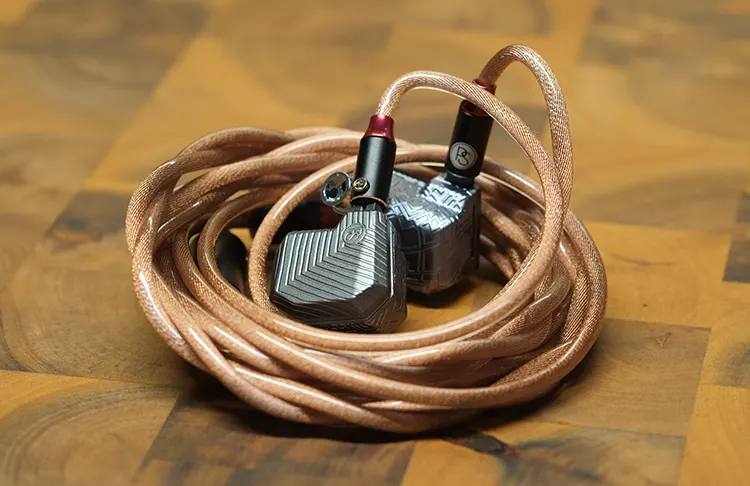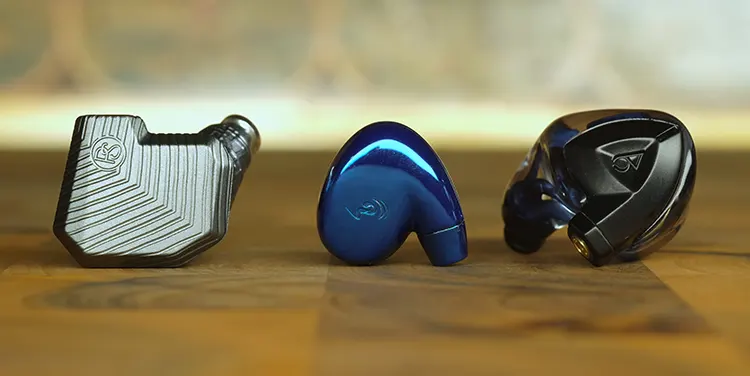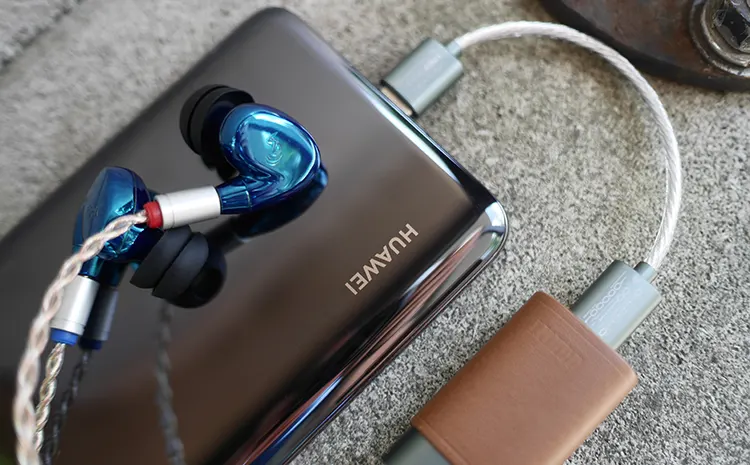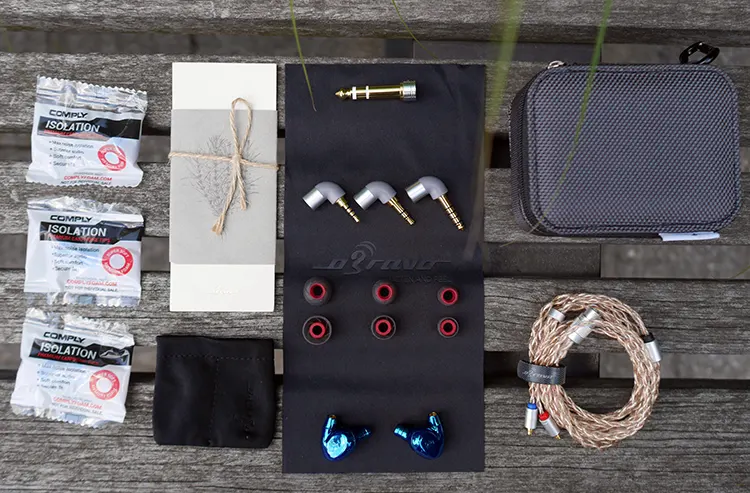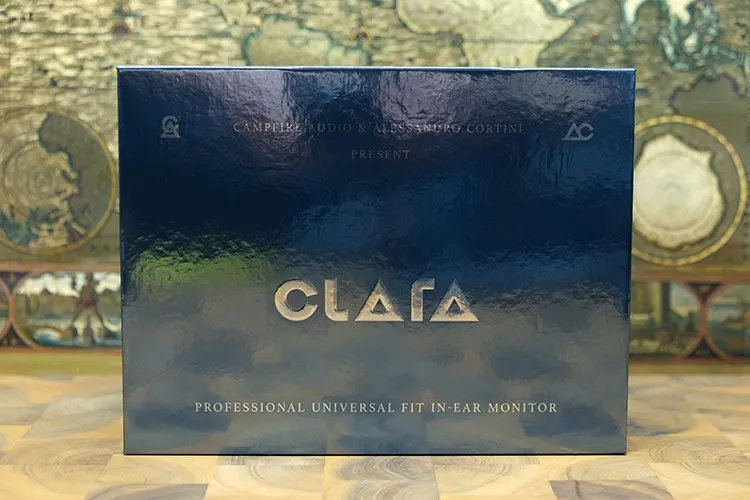Synergy
Efficiency & Sensitivity
This earphone has a sensitivity of 94 dB @ 1kHz and an impedance of 13.3Ω @ 1kHz.
Given how easy Clara was to raise the volume, I was expecting its specifications to be more in line with Campfire Audio’s Andromeda lineup. It requires very little effort to reach listening levels and tests the low-volume output of many of my devices.
Another reason I was expecting less demanding specifications is background noise. Clara teases it out of a few of my sources that sound dead silent with most other earphones.
Pairings
I used the ALO Audio Pilot, FiiO KA15, and Shanling M1 Plus to test the Clara.
The included ALO Audio Pilot provided a solid experience. High volume output was not an issue, as when plugged into my Huawei P40, even at the lowest possible volume, it was still louder than I preferred.
The Pilot emphasized Clara’s smoothness and warmth, resulting in a comforting sound experience that was good for a relaxing listen. Compared to the other devices we’ll discuss, mid-range clarity suffered slightly, and the highs seemed to lose some of their brilliance region spark.
FiiO’s KA15 provided a stellar experience and thanks to onboard EQ and filter options, was a versatile companion for Clara. Volume output was acceptable thanks to the KA15’s inclusion of onboard volume controls.
Its sound signature was like the Pilots but with improved dynamics. The low end had more punch, the mid-range had improved vocal clarity, and the highs were more vibrant but remained non-fatiguing.
Where the KA15 stumbled was in noise output through the balanced out. Clara revealed hiss to sully what is usually a black background, though it was easily covered up when playing music at even very low volumes.
Shanling’s M1 Plus provided nearly the same auditory experience as FiiO’s KA15 but with a more balanced, even tuning and a cleaner background, though there was still some hiss to be found from the balanced output.
Given it’s a DAP and acts as a standalone device, unlike the Pilot or KA15 which require a source, the M1 Plus’s versatility with the Clara was unmatched.
It offers the same balanced output options as the KA15 but with even more power. It also has similar EQ and filter options to fine-tune the signature. Volume output was also perfectly usable in either direction.
Select Comparisons
PLUSSOUND VOLTA
Technical
Clara is a hybrid while VOLTA is a tri-brid. Clara features a 10mm dual-magnet dynamic with a bio-cellulose diaphragm and three armatures. The VOLTA utilizes dual 10mm dynamics, dual armatures, and dual electrostatic drivers with a 6-way crossover managing everything.
The two models’ housing materials are entirely different. The VOLTA is entirely aluminum, from the faceplate to the body to the nozzles, with a 3D-printed acoustic chamber to house the drivers, while Clara is 3D-printed acrylic with a metal faceplate and nozzle.
The VOLTA uses common 0.78mm 2-pin connectors with rhodium-plated, tellurium copper pins, while Clara uses MMCX ports featuring Campfire Audio’s beryllium/copper mix for added durability.
Clara is easier to bring up to volume than the VOLTA so I would rate it as slightly more sensitive.
Design
Campfire Audio’s Clara is a considerably more ergonomic earphone thanks to its low-profile, custom-inspired design that hugs the ear, even if it is just as big.
In contrast, the VOLTA’s rectangular shells aren’t uncomfortable, but they are clumsy and lacking in stability in comparison.
Despite the size and all-metal design, the VOLTA is lighter at 8.2g (no tip) vs. 8.9g. This weight isn’t felt when wearing the Clara as it does a better job of evenly distributing the weight around and across your ear.
Clara’s cables aren’t as premium feeling, which makes sense given the sheer girth and beefiness of the VOLTA’s cable and hardware. The user-serviceable plugs also add to the premium nature of the cable’s design.
Where I prefer Campfire Audio’s cables are in actual use. The Time Stream cables are thinner, more flexible, more resistant to noise, and roughly half the weight (~25.5g to 50g) making for a considerably more pleasant wearing experience.
Visually, both earphones are good-looking products, however, the VOLTA is more unabashedly attention-grabbing.
The various shapes and designs that adored the faceplate and inner body, along with the gunmetal and grey two-tone color scheme are bolder than the smooth shells and matte black and transparent blue of the Clara.
Neither model isolates particularly well, though the VOLTA is a clear step up. In the same noisy coffee shop environment, the VOLTA required less of a volume bump to cover up sounds bleeding in.
Bass Performance
The 10mm dual-magnet dynamic handling Clara’s low end provides more extension than the VOLTA’s twin 10mm dynamic setup. Emphasis is also greater across the board, giving Clara a warmer tonality and a more visceral presentation.
The dual-magnet setup is also quicker, with notes hitting harder and faster and decaying more rapidly. The VOLTA’s dynamics bring more texture and micro-detail to the forefront, though Clara is no slouch in this regard.
Mids Performance
The VOLTA’s midrange is cooler and more forward than Clara’s, with a default vocal positioning set slightly further from the inner ear. Its presentation is also leaner, emphasizing the fine details and keeping vocals and instruments clearer amid heavy bass.
The VOLTA’s midrange is more evenly emphasized with the rest of the signature giving vocals more presence in the same tracks. It has a cooler presentation too, which adds to the VOLTA’s more traditional reference-style tuning.
Neither suffers from adding sibilance or exacerbating it when already present in a track. Clara’s warmth and generally smoother presentation ensure it takes more edge off sibilant tracks than the VOLTA.
Treble Performance
Both models offer excellent extension into the upper ranges, though emphasis for Clara rolls off early giving it a clear presence region bias. Clara’s brilliance region is quite tame with just enough emphasis to maintain some shimmer and sparkle when needed.
In contrast, VOLTA’s presence/brilliance region balance is flatter but more emphasized across the board against Clara. The result is a leaner sound with more perceived detail and clarity.
The VOLTAs electrostatic drivers are even snappier than the dual T.E.A.C. enhanced armatures in the Clara.
This plus a leaner presentation gives VOLTA a greater sense of air, though both models are free of splash or looseness and offer equal levels of control and tightness in their note presentation.
Staging Performance
Staging is a big plus for both models, each displaying their spacious presentations differently. VOLTA’s leaner, cooler sound and more distant default vocal positioning give the impression that the listener is enveloped by an evenly rounded, airy stage that surrounds them.
In contrast, staging for the Clara builds off a strong bass floor to give the impression that the listener is immersed in the track. The presentation is less dynamic as movement is restricted to a flatter plain, but it also comes across as more natural.
Channel-to-channel movement is very precise from both earphones, with the VOLTA’s more technical presentation giving it a small precision advantage.
This carries over to layering where the VOLTA is more dynamic, but not to instrument separation where it is equally easy to dissect individual track elements with either.
oBravo Clio
Technical
Both models are hybrid earphones. Clara contains a dynamic and three armatures to the Clio’s 9mm dynamic and 6mm AMT tweeter.
The build and materials are quite different. The Clara utilizes 3D-printed acrylic with a metal faceplate and nozzle and a custom-inspired, ergonomic design. oBravo went with a more compact, straightforward low-profile design, though made of brass, putting it in a higher weight class.
MMCX connectors with beryllium/copper connectors are in place for Campfire Audio’s Clara. oBravo makes use of their oB-MMCX standard for the Clio, limiting 3rd party cable options.
Clara is easier to bring up to volume than Clio though the load gap is not that different at 13.3Ω for the Clara and 16Ω for the Clio.
Design
Both models feature universal designs but take different approaches to get there. The Clio is a fraction of the size and lower profile with a more basic bean-like shape and zero protrusions that allow it to rest gently in the outer ear.
Clara is quite large, enough to fill the entirety of my outer ear. Numerous protrusions help it lock into the outer ear resulting in a more secure fit.
The Clio’s face is just as featureless as the inner half, save for a subtle debossed logo. Campfire Audio’s logo is recessed within a triangular motif on Clara’s faceplate.
Both earphones are quite comfortable, but since Clara’s large size fills my outer ear, it never “disappears” so to speak. As such, the Clio is the less intrusive product to wear over long periods, even if the lack of ear guides means the cable slips out of place occasionally.
Both earphones offer an average level of passive isolation, making them better suited for indoor use. In the same noisy environments, I found a similar volume increase was necessary to block incoming noise and allow the earphones to reach a comfortable listening level.
Both earphones come with high-quality cables with well-designed metal hardware for the plugs and y-split. oBravo’s cable features a modular plug system though, eschewing the need for multiple cables to achieve balanced or single-ended outputs.
Campfire Audio’s cable better handles noise, tangling, and memory, and has a universal MMCX design with durable beryllium copper ports. It also has preformed ear guides that result in a more secure fit.
Bass Performance
The Clio’s 9mm dynamic bass performance is quite good. It offers solid depth, sub-bass feedback, and mid-bass punch, but it falls a step behind Clara’s 10mm dual-magnet setup.
Clara’s driver is quicker, better controlled, and provides more visceral feedback on deep notes. It also has a smoother presentation with more mid-bass punch and a more natural tonality.
Along with offering a smoother, more refined sound, Clara’s dynamic also provides a more detailed and textured presentation than Clio’s 9mm. The Clio’s performance is good, but not in line with what Clara can do.
Mids Performance
Through the midrange the Clio sees additional emphasis, putting vocals and instruments more in line with what the low end is doing than what we hear out of Clara. Its default vocal positioning is slightly further from the inner ear.
The Clio’s tonality is brighter and less natural than Clara’s but with a small edge in clarity. This goes with a cooler, leaner presentation that lacks the weightiness and density of Clara’s output.
Both models’ sibilance management is excellent, though I find it is handled better through Clara. The Clio’s drivers lack the smoothness and refinement of Clara’s multi-armature configuration, so they don’t soften the edge of harsh tees and esses as effectively.
Treble Performance
Clio’s treble presentation is much more vibrant and aggressive than what we hear from Clara. Extension from the Clio is even better with more brilliance region energy that gives it a more lively and energetic presentation.
The AMT driver’s speed and urgency certainly help with this, since it attacks and decays even more quickly than the already rapid armatures in Clara. Both provide similar levels of detail, though Clara’s more downplayed emphasis somewhat masks this.
Clio’s more bombastic presentation comes at the expense of fatigue, especially when raising the volume. A looser note presentation that suffers from some splash where there is none from Clara also makes Clio’s listening experience more tiring.
Staging Performance
Both models offer strong staging performance fitting for their price range. Clara’s stage is wider and deeper, while the Clio does a better job with depth and height, though the differences are minor.
I found Clara’s staging to be more natural and immersive thanks to its stronger mid-bass presence giving it a more defined floor on which the rest of the stage is built.
The Clio’s cooler, leaner presentation results in greater spacing between instruments and track elements resulting in an airier feel about it.
Both models’ imaging performance is great, with smooth transitions from channel to channel and nuanced movement just off-center and to the edges of their respective stages.
Clio’s instrument layering is slightly better while the separation qualities of the Clara stand out more.
My Verdict
Campfire Audio’s collaboration with Alessandro Cortini to make Clara has been a resounding success. From a tuning perspective, this is one of Campfire Audio’s best products to date.
It offers the sort of bombastic bass experience Campfire Audio fans have come to expect, without crossing over into bass-head territory, while softening the upper frequencies to make them non-fatiguing. This does not come at the expense of detail, clarity, or mid-range presence, which has been handled brilliantly.
In addition to being technically adept and smartly tuned, the next most impressive thing about Clara’s tuning is just how refined and effortless it sounds.
With any genre and volume I tested at, Clara never sounded like it was struggling or straining and played tracks, and with a smoothness that only a handful of earphones I’ve heard come close to.
The rest of the experience is just as good. The ergonomic shells are comfortable and visually appealing, and the accessory kit is straight-up S Tier thanks to the inclusion of things like the hard case, Pilot DAC, balanced and single-ended cables, and premium final TYPE E ear tips.
Beyond Clara’s potentially being too big for small ears and its somewhat picky source selection, there’s little to complain about.
If you’re not a treble-head or highly averse to elevated bass levels, the Clara is an easy recommendation and one of the most well-rounded and performant earphones I’ve tested to date. It’s starting my 2025 off with a bang and a half and will be hard to top.
Campfire Audio Clara Technical Specifications
- Frequency Response: 5Hz–20kHz
- SPL: 94dB @ 1 kHz: 9.95 mVrms
- Impedance: 13.3 Ohms @ 1 kHz
- THD: <0.3%

